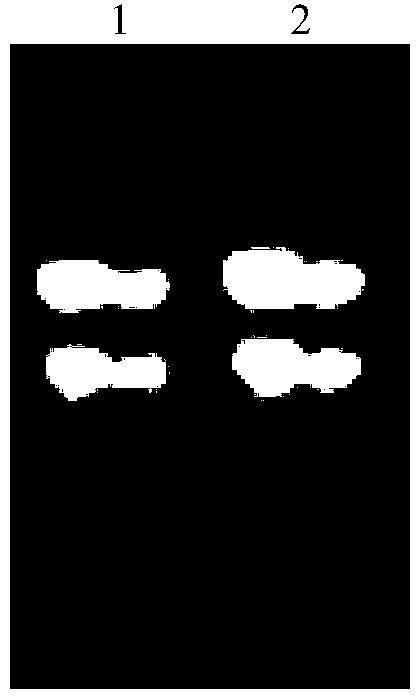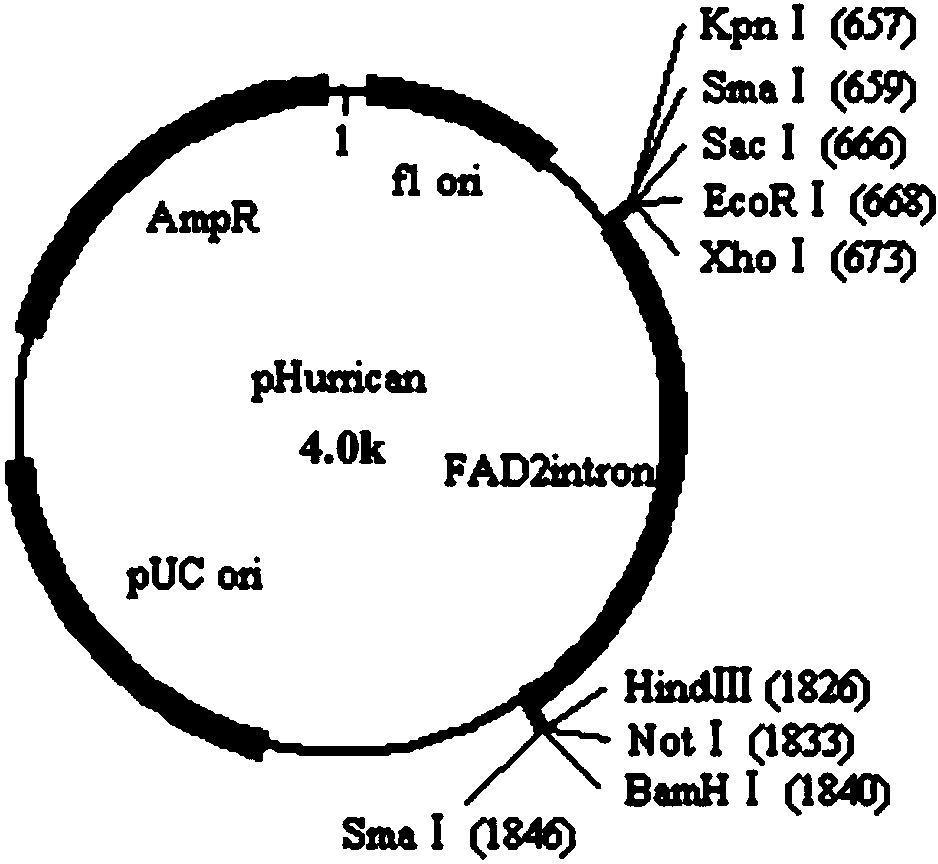DNA (deoxyribonucleic acid) molecule for expressing hairpin type RNA (ribonucleic acid) for suppressing sitobion avenae carboxylesterase and application of DNA molecule
A technology of Aphid spp reduced effect
- Summary
- Abstract
- Description
- Claims
- Application Information
AI Technical Summary
Problems solved by technology
Method used
Image
Examples
Embodiment 1
[0057] Example 1. Obtaining of DNA Molecules Expressing Hairpin RNA that Inhibits Aphidida carboxylesterase
[0058] 1. Acquisition of the target fragment of SaCbE E4 of the aphids carboxylesterase gene
[0059] Design the following 2 pairs of primers P1-sF / P1-sR and P1-asF / P1-asR:
[0060] P1-sF: 5'- GGATCC AAGTATTGCGCAAGATGAGGGTC-3' (the underline is the Bam H I restriction site, and the following sequence is the 1-23rd position of sequence 1);
[0061] P1-sR: 5'- AAGCTT GCTACGTAAGAATAATTACCAC-3' (the underline is the Hind III restriction site, and the following sequence is the reverse complementary sequence of the 324-345th position of sequence 1).
[0062] P1-asF: 5'- GGTACC AAGTATTGCGCAAGATGAGGGTC-3' (the underline is the KpnI restriction site, and the following sequence is the 1-23rd position of sequence 1);
[0063] P1-asR: 5'- GAGCTC GCTACGTAAGAATAATTACCAC-3' (the underline is the Sac I restriction site, and the following sequence is the reverse complement...
Embodiment 2
[0086] Example 2, the acquisition and identification of RNAi transgenic wheat of SaCbE E4
[0087] 1. Acquisition of SaCbE E4 RNAi transgenic wheat
[0088] Select the young ears of the wheat variety Liaochun No. 10 12-15 days after flowering, sterilize the seeds, remove the immature embryos, place the scutellum up on the immature embryo inoculation medium (formula: MS basic medium + 2,4- D2mg / L + sucrose 30g / L + agar powder 7g / L, pH 5.8. Each concentration is the final concentration of the corresponding components in the medium), cultured in the dark at 25±1°C for 3-5 days to induce wheat callus. Select callus pieces with good growth status for gene gun co-transformation (mix pBAC-rbcs-CbE E4 and pBAC35SIH3 at a molar ratio of 3:1, wherein the pBAC35SIH3 plasmid carries the resistance gene bar of the herbicide Basta), and the transformed After the callus was cultured in the dark at 25±1°C for 2-3 days, it was transferred to the selection medium (recipe: immature embryo inocu...
Embodiment 3
[0099] Example 3, Study on the effect of RNAi transgenic wheat of SaCbE E4 on the control of the aphid
[0100] Aphids aphids population, three generations of aphids were raised indoors, during which no insecticides were ever applied. The indoor breeding temperature is 21±1°C, the relative humidity is 50-60%, and the photoperiod is L:D=16h:8h. Aphids were raised on aphid-sensitive wheat variety Jing 411, and fresh seedlings were replaced every two weeks for aphids.
[0101] 1. Analysis of the interference effect of SaCbE E4 RNAi transgenic wheat on the expression level of the carboxylesterase gene of A.
[0102] The Aphid aphid in the first instar nymph stage was used as the experimental material, and they were fed on T 3 Generation of SaCbE E4 RNAi transgenic lines SadsCbE1-5 and SadsCbE2-2 at the two-leaf one-heart seedling stage on 1 day, 3 days, 5 days (single plant isolation with gauze). Using qRT-PCR to analyze the expression level of carboxylesterase gene in the tube...
PUM
 Login to View More
Login to View More Abstract
Description
Claims
Application Information
 Login to View More
Login to View More - R&D
- Intellectual Property
- Life Sciences
- Materials
- Tech Scout
- Unparalleled Data Quality
- Higher Quality Content
- 60% Fewer Hallucinations
Browse by: Latest US Patents, China's latest patents, Technical Efficacy Thesaurus, Application Domain, Technology Topic, Popular Technical Reports.
© 2025 PatSnap. All rights reserved.Legal|Privacy policy|Modern Slavery Act Transparency Statement|Sitemap|About US| Contact US: help@patsnap.com



